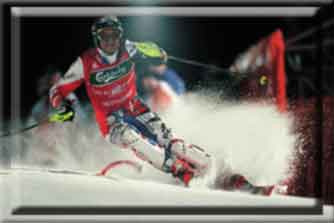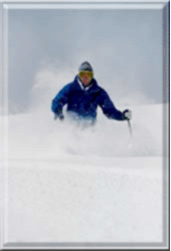Movement control
One of the questions that ski instructors get asked is: "How do you make that look so easy?" The trouble is,
"practice" is not really a fair answer.
Practicing the wrong things just makes you better at doing the wrong things, and frustration and confusion
are the result. No matter if you only ski for one or two weeks a year, there are some sure fire ways of
improving your skiing without getting over technical. In order to get improvement though, it helps to
understand why things work the way they do.
Good skiers can make their movements bigger or smaller, softer or harder, faster or slower and more or less
accurate at will. The trouble is many who grew up on skis have forgotten how they learned those skills. This is where for the rest of us really effective ski lessons help.
The truth is, for those who grew up here as children, they went and played on the snow, they did lots of different things; but since they were usually
with local ski clubs, they were guided, they "played" with focus.
Youngsters don't realise they are learning anything, but their coaches do and what follows over the next
few articles is how, with the benefit of top class ski instruction; ordinary unfit holiday skiers can start to feel a measurable improvement.
Look at the two photographs below. Both skiers look pretty good and it's easy to be envious, after all most
of us would love to be able to race that fast, or to be able to ski waist deep powder and make it seem effortless.

Both skiers look different, one is clattering down the hill as fast as he can go - and the other - is seemingly standing still, floating through the snow.

Is what we see true though? Are the skiers trying to do what we think?
The racer - is not only travelling fast but has to make rapid movements to turn through the gates. In
addition certain turns may require a lot of power to maintain a change of direction and keep
"the racing line", but the aim is to be light and soft so that overall speed is kept high.
It just looks incredibly powerful.
The powder skier looks way different. Floating effortlessly, and true, often it can feel like that, but
that's not the whole story. Just to overcome the resistance of the snow - particularly once it is over knee
deep, the skier has to travel quite fast just to be able to turn at all!
The terrain underneath is not normally level, unless the runs are groomed each night - so movements have to
be both powerful and rapid to cope with the undulations. Sometimes skis will slow down in extra deep areas
so the power has to be on all the time in order that the turns can be strong and accurate. When it all goes
well? Absolutely fantastic!!
The two skiers movements are much more alike than one thinks. So here's how to go about getting really good
movement control.
What we will deal with first is range of movement.
You will often overhear lessons in ordinary ski schools and the most common thing you hear is "Go Up and Down". The difference between this simple explanation and one you will get from a top class ski school is that you will be told how, why and what you are meant to do.
Up and down until the cows come home - it may sound boring and it may sound daft but there is a
purpose - no matter how badly put.
In order to ski well, a large range of movement should be available to cope with the unexpected and to
perform well under changing conditions. This applies whether you are skiing blue runs or steep mogul fields. What instructors try to do is to encourage large movements just in case they are needed.
The reason why is simple, if you make large powerful movements it is easier to change them to smaller more
delicate ones than the other way round.
Here are some exercises to help you learn the full movement range.
The first thing to do is work within your own fitness level. You may not be as fit as your ski instructor, so if you can't try these exercises any more than a
couple of times, then twice is better than none at all!
Whether going straight, traversing or starting each turn, try to hop, clear into the air and dangle your
legs beneath you. Try to land smoothly and continue on as if nothing has happened at all. Try to vary this
between huge leaps - (for you that is!) and scarcely any movement at all.
Try skiing with very bent legs all the time or with almost straight and rigid legs - very scary in a mogul
field! Then try to leap off very small bumps - use them as a take-off ramp, and land on the downward slope of
a small dip so the landing is as smooth as silk.
You don't have to do all of this, but the idea is to gently expand what you can do; to gently expand your
own comfort zone so that you can vary what you do at will. Best of all, you can do this at your own pace.
You can hop on one leg, try running, (it's like running on the spot but whilst sliding on skis), run around
turns (try to open the lower (inside) ski tip first). Or try stepping up the hill in traverses, from small
to big steps and back again.
The whole point is, if you try all this whilst you are skiing for yourself and use the focus and ideas
from your ski lessons; by the end of the week the difference will be enormous. Because good practice complements
good coaching, and only perfect practice makes perfect, lessons and focussed play work together perfectly.
The good bit is you can do all this as often as you want and as much as you want. The only boss is you! When
you're sitting in a deckchair in the sun at the end of the week, you'll know that this time progress was real
and not just an empty complement from yet another Instructor...